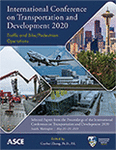International Conference on Transportation and Development 2020
Before-After Study of Signal Timing Improvement Using Crowd-Sourced Data: A Case Study of Omaha
Publication: International Conference on Transportation and Development 2020
ABSTRACT
Traffic signals are typically retimed to accommodate traffic conditions during a period of observation. A set of robust measures are needed to determine the effectiveness of signal improvement technique. The present study utilizes five such measures developed in previous research: median travel rate, within-day variability of travel rate, median travel rate dispersion, and overall travel rate variability to evaluate the effectiveness of signal improvement. Cumulative distribution function plots are constructed initially using travel rate, which is used to identify the atypical days. The atypical days, representation of variable travel rate reduced for 67% of the segments suggesting an improvement of travel time variability. These atypical days are removed, followed by an evaluation to assess the change of travel rate and its variability. The within-day variability was the only parameter that improved significantly. A statistical measure on weekly measures stated that there were few segments with actual change in before-after condition.
Get full access to this article
View all available purchase options and get full access to this chapter.
REFERENCES
Administration, National Highway Traffic Safety, and others. 2009. “An Examination of Driver Distraction as Recorded in NHTSA Databases.” DOT HS 811: 216.
Antonucci, Nicholas D., Kelly Kennedy Hardy, Kevin L. Slack, Ronald Pfefer, and Timothy R. Neuman. 2004. “Volume 12: A Guide for Reducing Collisions at Signalized Intersections.” In Guidance for Implementation of the AASHTO Strategic Highway Safety Plan. https://doi.org/10.17226/13545.
Anžek, Mario, Z Kavran, and D Badanjak. 2005. “Adaptive Traffic Control as Function of Safety.” 12th World Congress on Intelligent Transport Systems and Services, San Francisco. http://trid.trb.org/view.aspx?id=767453.
Chandler, Brian E., Myers C. Matthew, Jennifer E. Atkinson, Thomas E. Bryer, Richard Retting, Jeff Smithline, Jeff Trim, et al. 2013. “Signalized Intersections Informational Guide.” https://safety.fhwa.dot.gov/intersection/conventional/signalized/fhwasa13027/fhwasa13027.pdf.
Comert, Gurcan. 2013. “Effect of Stop Line Detection in Queue Length Estimation at Traffic Signals from Probe Vehicles Data.” European Journal of Operational Research 226 (1): 67–76. https://doi.org/10.1016/j.ejor.2012.10.035.
Comert, Gurcan, and Mecit Cetin. 2009. “Queue Length Estimation from Probe Vehicle Location and the Impacts of Sample Size.” European Journal of Operational Research 197 (1): 196–202.
Day, Christopher M., Darcy M. Bullock, Howell Li, Stephen M. Remias, Alexander M. Hainen, Richard S. Freije, Amanda L. Stevens, James R. Sturdevant, and Thomas M. Brennan Jr. 2014. “Performance Measures for Traffic Signal Systems: An Outcome-Oriented Approach.” https://doi.org/10.5703/1288284315333.
Day, Christopher M, and Darcy M Bullock. 2010. “Performance Based Management of Arterial Traffic Signal Systems.” Vol. 1.
Day, Christopher M, Stephen M Remias, Howell Li, Michelle M Mekker, Margaret L McNamara, Edward D Cox, and Darcy M Bullock. 2015. “Performance Ranking of Arterial Corridors Using Travel Time and Travel Time Reliability Metrics.” Transportation Research Record: Journal of the Transportation Research Board, no. 2487: 23p. https://doi.org/10.3141/2487-04.
“Fatality Facts.” 2017. Highway Loss Data Institute. 2017.
Fernandes, Paulo, Tânia Fontes, Mark Neves, Sérgio Ramos Pereira, Jorge M. Bandeira, Nagui M. Rouphail, and Margarida C. Coelho. 2015. “Assessment of Corridors with Different Types of Intersections.” Transportation Research Record: Journal of the Transportation Research Board 2503: 39–50. https://doi.org/10.3141/2503-05.
Gordon, Robert L. 2010. “Traffic Signal Retiming Practices in the United States.” NCHRP Synthesis 409. Vol. FHWA. https://doi.org/10.17226/22915.
Hicks, Brandy, and Mark Carter. 1997. “What Have We Learned About ITS? Arterial Management.” In. https://doi.org/10.1093/oxfordhb/9780199653881.013.046.
List, George F., Billy WIlliams, Nagui Bouphail, Rob Hranc, Tiffany Barkley, Eric Mai, Armand Ciccarelli, et al. 2014. “Establishing Monitoring Programs for Travel Time Reliability.”
Sharma, Anuj, Darcy M. Bullock, and James A. Bonneson. 2007. “Input-Output and Hybrid Techniques for Real-Time Prediction of Delay and Maximum Queue Length at Signalized Intersections.” Transportation Research Record: Journal of the Transportation Research Board 2035: 69–80.
Sharma, Anuj, and Darcy M Bullock. 2008. “Field Evaluation of Alternative Real-Time Methods for Estimating Approach Delay at Signalized Intersections.” In International Conference on Application of Advanced Technologies in Transportation, 1–14.
Sharma, Anuj, Subhadipto Poddar, John Shaw, Neal Hawkins, and Skylar Knickerbocker. 2018. “Performance-Based Operations Assessment of Adaptive Control Implementation in Des Moines, Iowa.”
Sims, A. G., and K. W. Dobinson. 1980. “The Sydney Coordinated Adaptive Traffic (SCAT) System Philosophy and Benefits.” IEEE Transactions on Vehicular Technology 29 (2): 130–37. https://doi.org/10.1109/T-VT.1980.23833.
Sprague, David. 2012. “Adaptive Signal Timing Comparison between the InSync and QuicTrac Adaptive Signal Systems Installed in Colorado.” https://www.codot.gov/programs/research/pdfs/2012/adaptivesignaltiming.pdf.
Sunkari, Srinivasa. 2004. “The Benefits of Retiming Traffic Signals.” ITE Journal 74 (4): 26–29.
“Systems Analysis and Design of the Traffic Control System/Introduction.” 2017. WikiBooks. 2017.
Zhao, Yi, and Zong Tian. 2012. “An Overview of the Usage of Adaptive Signal Control System in the United States of America.” Applied Mechanics and Materials 178–181: 2591–98. https://doi.org/10.4028/www.scientific.net/AMM.178-181.2591.
Information & Authors
Information
Published In
International Conference on Transportation and Development 2020
Pages: 270 - 279
Editor: Guohui Zhang, Ph.D., University of Hawaii
ISBN (Online): 978-0-7844-8315-2
Copyright
© 2020 American Society of Civil Engineers.
History
Published online: Aug 31, 2020
Published in print: Aug 31, 2020
Authors
Metrics & Citations
Metrics
Citations
Download citation
If you have the appropriate software installed, you can download article citation data to the citation manager of your choice. Simply select your manager software from the list below and click Download.
